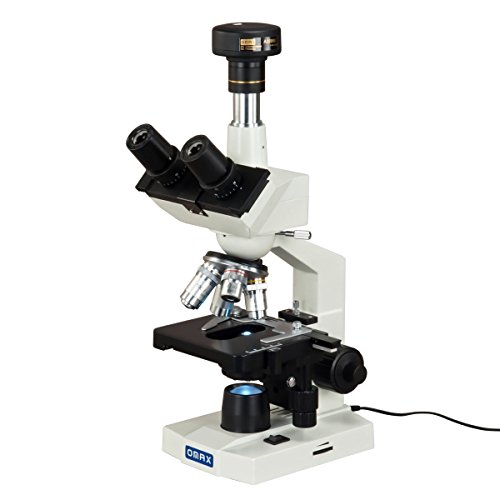[Top 9] Best Microscope for Kids (2024)
The right microscope for you and your kids is going to depend on what you want to do with the microscope, your budget, and your familiarity with microscopes. So here’s a guide to help you navigate the available products and find the best microscope for kids that might interest you.
Celestron PentaView LCD Digital Microscope is our top overall pick because it has the best imaging capabilities, magnification, a full-color LCD viewer, and all the best hardware.
Related Post: Best Microscopes for Viewing Bacteria
Best Overall — Celestron PentaView LCD Digital Microscope

Celestron PentaView LCD Digital Microscope
An LCD color viewer microscope for real-time visualization of your sample.
The Celestron PentaView LCD Digital Microscope has it all: imaging capabilities with a 5 MP full-color built-in camera, an LCD color viewer for real-time visualization of your sample, magnification up to 2400x, and even included 4 GB SD card and AV cable so you can project your science onto a TV or projector screen. This may be far more than you need and there are more budget-friendly options reviewed below. But if you’re looking for the best of the best, look no further.
Celestron has other Digital Microscope with LCD viewers similar to the PentaView. If you don’t need the 2400x magnification but love the idea of the LCD viewer, check out the more affordable LCD Digital Microscope II, which still includes the 5 MP camera, LCD viewing screen, and mechanical stage.
Best Introductory Microscope — AMScope 120x-1200x Kids Beginner Microscope

AMScope Kids Beginner Microscope
An affordable microscope with all the starting materials for children to set up their own laboratory.
The AMScope 120x-1200x Beginner Microscope 52-piece set is an affordable microscope that includes all the starting material for your child to set up their own laboratory in your kitchen (playroom, living room, etc.). This microscope is equipped with 6 different objectives offering a range of magnifications from 120x to 1200x. With magnification up to 1200x, they will be able to observe single cells, bacteria, and more. This monocular (one eyepiece) compound light microscope is lit by an LED bulb as well as mirrors. Because this microscope is battery-operated, you can take it anywhere (in it’s included carrying case!).
The scope itself is solid and a great starting microscope, but this kit is our top pick for younger kids because of the included supplies. First, this Beginner Microscope includes blank reusable slides for observing your own specimens as well as all the materials to prepare those specimens (forceps, specimen microtome, scalpel, petri dish, spatula, needle, eosin stain, slides, slide covers, labels, etc.). It also comes with instructions and materials for pre-planned experiments to get you started.
Best for Outdoors — Carson Microbrite 20x-40x LED Pocket Microscope

Carson Microbrite Pocket Microscope
A pocket microscope — perfect for outdoor exploration.
The Carson Microbrite Pocket Microscope is great to take outdoors and explore nature with your kids. It’s also an inexpensive tool that could be purchased in bulk for a classroom. It includes sample slides so you can prepare specimens or – thanks to the removable base – just hold it directly up to whatever you’d like to see more closely (tree bark, a leaf, soil, etc.). The magnification maxes out at 40x, so you won’t be inspecting microbes with this Pocket Microscope, but it is a great on-the-go tool that can help your child or students explore nature.
Best for Images and Video — OMAX 40x-2500x Digital Microscope

OMAX Digital Microscope
A digital microscope with built-in 5MP camera, compatible with all major operating systems.
The OMAX 40x-2500x Digital Microscopewould be our top pick for a digital microscope in large part because it comes equipped with a built-in 5MP digital camera and includes software for image and video capture, annotating, editing, measurement and more that is compatible with all major operating systems (macOS, Windows, Linux).
Importantly, this digital microscope also provides the greatest magnification of any microscope on this list. It is equipped with two eyepieces and four objectives (4x, 10x, 40x, 100x). It has a mechanical stage, which is especially important at higher magnifications to ensure smooth movement of the specimen. It even comes equipped with oil for use with the 100x objective.
Best for Imaging on a Budget — AMScope 40x-2500x Digital Microscope

AMScope Digital Microscope
Compatible with Windows operating systems.
The AMScope 40x-2500x Digital Microscope is less expensive than the OMAX digital microscope. The main difference here is the built-in camera and the provided software. Both microscopes have the same magnification capabilities and a mechanical stage. However, the AMScope 40x-2500x is equipped with a 0.3 MP Camera. Further, the provided software is only compatible with Windows operating systems. If you’re a Windows user and the lower resolution camera is suitable for your needs, this is a great digital microscope option.
Best Portable Option — AMScope 40x-1000x Compound Microscope

AMScope Compound Microscope
A portable, battery-operated microscope, great for field use.
If you are not in need of imaging capabilities, it really comes down to the microscope hardware. The AMScope 40x-1000x Compound Microscope provides enough magnifying power to see bacteria, plants, and animal cells. It can also be battery-operated making it a portable option. It does have a fixed stage rather than a mechanical stage like others on this list, but without the option for higher magnification, this may not be as important.
If you’d like to give this microscope an imaging capability, you can purchase an attachable suction cup to use the camera on your smartphone to capture images. Conversely, a very comparable microscope from TELMU, the 40x-1000x Dual Cordless LED microscope (reviewed below), comes equipped with this attachment.
Budget Cordless Microscope — TELMU 40x-1000x Dual Cordless LED Microscope
TELMU Dual Cordless LED Microscope
It comes with an adaptor for turning your smartphone into imaging capture hardware.
As mentioned above, the TELMU 40x-1000x Dual Cordless LED Microscope is comparable to the AMScope 40x-1000x in every way: it has a fixed stage, is cordless for easy transport, and provides the same range of magnifications. Plus, it comes with an adaptor for turning your smartphone into imaging capture hardware and a box of prepared slides to get you started.
Best Budget Option with Higher Resolution — OMAX 40x-2000x Binocular Microscope

OMAX Binocular Microscope
A high resolution microscope with manual stage.
The OMAX 40x-2000x Binocular Microscope has nearly as good of resolution as the digital microscopes we reviewed above and also includes a mechanical stage. This is a powerful microscope and a great option if you need the resolution but don’t need to take images or video.
Best Easy-to-Use Microscope — Plugable USB Digital Microscope

Plugable USB Digital Microscope
USB connectable microscope with 2.0 MP camera.
This Plugable USB Digital Microscope is very easy to use. All you have to do is plug it into a laptop or computer with the provided USB and you are ready to go. With a 250x magnification, it will not provide you the same magnification as other options on this list. However, with its 2.0-megapixel camera, it is a great way to produce digital content. Samples are illuminated with LED ring light and the microscope comes on an adjustable arm to get just the right angle.
What to Consider When Buying a Microscope
Type of Microscope
Light microscope? Compound? Simple? Dissecting? Binocular? Stereo microscope? It can seem overwhelming to choose a microscope. How do you know where to begin? First, it’s important to distinguish how these microscopes differ. A simple microscope uses only a single lens to magnify the sample (think magnifying glass) while a compound microscope uses two sets of lenses, providing a much greater range of magnification.
Most importantly, because of the two sets of lenses, the image you observe through the eyepiece of a compound microscope is inverted from the actual sample. If you are connecting your microscope to a laptop for viewing, the software likely corrects this. The term “light microscope” simply means that visible light is used to illuminate and magnify the sample. A light microscope can be either a compound microscope or a stereomicroscope – sometimes also referred to as a dissecting microscope.
A stereo microscope has two pairs of lenses (basically two compound microscopes in one) that allow the same focal point to be viewed at two different angles, providing a 3D image. Typically, stereo microscopes have much lower magnification.
You may also see the terms monocular, binocular, and trinocular in the description of a microscope. This refers to the number of eyepieces. There isn’t a huge benefit to a binocular over the monocular eyepiece and for most, it will simply be a matter of preference. You might wonder why trinocular microscopes exist (there can’t possibly be a larger market for three-eyed individuals!). The third eyepiece is used for imaging capabilities (i.e. a camera).
Magnification
Magnification is going to be a very important characteristic when choosing the best microscope for you and your children. Depending on what you want to do with your microscope, a simple microscope with 100x magnification might be all you need. However, to observe bacteria, single cells or cell structures, crystal structures, etc. you will need more power. For a compound microscope, the total magnification is determined by multiplying the magnification of the objective with the magnification of the eyepiece. We have made sure to highlight the magnification ranges for each microscope we’ve reviewed.
Image Capture and Software
There is a good chance you will want to take pictures and videos and/or analyze those images. If you are interested in producing high-quality visual content, you will want to ensure that the equipped camera meets your needs. Conversely, many trinocular microscopes will allow you to choose the best camera for your needs and are compatible with a wide range of equipment.
Another important feature is the included software. Some microscopes come with free software that will allow you to measure, annotate, and edit images and videos. If the microscope you want doesn’t come with the included software, there are several third-party programs that can be used instead. One last note: make sure the software is compatible with your operating system. Our top digital microscope, the OMAX 40x-2500x Digital Microscope, is compatible with all major operating systems (macOS, Linux, Windows), but that isn’t the case for all microscopes.
Frequently Asked Questions
What do I do with a microscope?
Whether you’re looking for activities for your classroom or for fun STEM activities with your own children, there are several resources available for inspiration. Check out our article on microscope activities for the middle school classroom. For teachers, a great resource is the Teachers Pay Teachers website where you can get free or inexpensive microscope lesson plans. The Microscopy Society of America also has some great resources and activity ideas.
Where can I learn how to use a microscope?
There are a ton of resources to teach you – or your kids – how to use a microscope. Check out this unit from the University of Washington with several introductory and cell biology-themed lesson plans for middle-school aged students. AMScope – who appears multiple times on this list of microscopes – has a handy introduction to how to use a microscope. Here is another great resource introducing compound microscopes from the University of Arizona. PBS also has some great resources for how to use dissecting and compound microscopes.
What magnification do you need to see bacteria?
In order to see bacteria, you will need a compound microscope with at least 400x magnification. To see much detail, you would likely look for a microscope with a minimum of 1000x magnification although affordable options can offer 2000x, 2500x, or more. Bacteria come in many different shapes and sizes but the common rod-shaped bacterium, E. coli, ranges in size from 0.2-0.5 μm in diameter and about 2-5 μm in length. Check out our buyers’ guide on selecting a microscope for viewing bacteria for more information and our top picks for viewing bacteria.
Last update on 2024-04-24 / Affiliate links / Images from Amazon Product Advertising API









